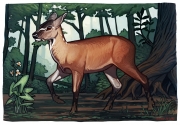Cobras have long fascinated human curiosity over time with their unique traits, such as the ability to stand erect, spit venom, and their distinctive hood that unfolds around their heads. Cobras are part of the Elapidae family and most of them belong to the genus Naja Today, they are widely distributed across Africa, the Arabian Peninsula, and South Asia.
But cobras also inhabited Europe during the Neogene period (which includes the Miocene and Pliocene). Evidence shows they were present in the Iberian Peninsula, including an extinct and possibly endemic species from the Late Miocene, Naja iberica, found only in this region. However, the fossil record of cobras on the peninsula is limited, leaving much of their evolutionary history a mystery.
Now, an international team from the Institut Català de Paleontologia Miquel Crusafont (ICP), the University of São Paulo (USP), the Muséum national d’Histoire naturelle de Paris (MNHN), the University of Turin (UNITO), the University of Granada (UGR), and the University of Bristol is studying fossil cobra vertebrae (Elapidae, Naja) from the Vallès-Penedès Basin. Their research focuses on the Middle and Late Miocene, aiming to demonstrate the persistence of these snakes in Iberia throughout much of the Miocene
Image 1. Fossils of precloacal vertebrae of Naja found at the Abocador de Can Mata site located in Hostalets de Pierola (Anoia): IPS42390, in anterior view (A), posterior view (B), dorsal view (C), ventral view (D), left lateral view (E), and right lateral view (F); IPS42218 in posterior view (G), anterior view (H), dorsal view (I), ventral view (J), left lateral view (K), and right lateral view (L). The scale bar represents 2 mm.
The analysis of the fossil vertebrae confirms for the first time the presence of cobras on the Iberian Peninsula before the Messinian Salinity Crisis. 'This crisis, which occurred around 6 million years ago, involved the gradual closure of the connections between the Atlantic Ocean and the Mediterranean Sea via the Strait of Gibraltar due to tectonic movements. This eventually led to the almost complete isolation and desiccation of the Mediterranean, significantly impacting the distribution of marine and terrestrial life in the region,' explains Andrea Villa, a researcher at the ICP and lead author of the article.
Before the Messinian event, species in the region faced the challenge of transitioning from a humid environment with abundant vegetation to a drier one with extensive grasslands. Despite these challenges, Iberian cobras seemed unaffected. The fossil material from various sites in the Vallès-Penedès Basin, dated to different ages before the crisis, shows no signs of adaptation problems. Their presence in these areas demonstrates not only the ecological flexibility of these snakes but also indicates that the climate was warm.
“According to molecular and paleontological analyses, cobras originated in Africa. However, their fossil records in Africa and Asia are scarce, leaving their evolutionary history in these areas uncertain," says Ana Bottallo Quadros, a paleontologist at the University of São Paulo and the MNHN. In Europe, cobras have been present almost since the beginning of the Miocene, with evidence suggesting they appeared in the Iberian Peninsula as early as in other parts of the continent. The identification of the endemic species Naja iberica points to unique processes of speciation and adaptation in this region. Fossils from the Vallès-Penedès Basin indicate that cobras continued to inhabit Catalonia until the Late Miocene. Their extinction in the Iberian Peninsula occurred before the end of the Pliocene.
Image 2. Potential dispersal routes of VPB Naja in the first half of the Miocene, showing the possible arrival either from an Eastern route through Central Europe (white arrow) or directly from Africa (black arrow). The precise origin of the Eastern lineage of European cobra is still uncertain. The cobra silhouette is made available by Chris Hay under a CC BY-NC 3.0 Deed license, through PhyloPic (https://www.phylopic.org/).
The research team highlights that numerous questions remain unanswered regarding the origin and dispersion of cobras before the Messinian event, emphasizing the need for additional cobra fossil discoveries to address these uncertainties. However, they underscore the significance of investigating the factors that led to their extinction, as this knowledge could hold significant implications for the conservation of present-day species.
Main image: Frontal photography of a Naja haje, by M. Sassoè and S. Acierno.
Original Article:
- Villa, A., Quadros, A. B., Delfino, M., Luján, À. H., Bolet, A., Casanovas-Vilar, I., Robles, J. M., & Alba, D. M. (in press). The rise and fall of the Iberian cobras (Elapidae, Naja) in the context of their European and global fossil record. Papers in Palaeontology. DOI: https://doi.org/10.1002/spp2.1575

















